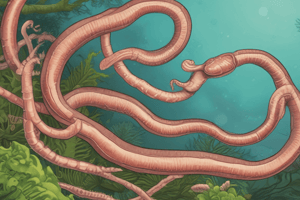Podcast
Questions and Answers
Which of the following is NOT a type of helminth?
Which of the following is NOT a type of helminth?
- Platyhelminth
- Protozoihelminth (correct)
- Nematoda
- Nematihelminth
The adult worm of Hymenolepis nana is found in which part of the human body?
The adult worm of Hymenolepis nana is found in which part of the human body?
- Liver
- Posterior ileum
- Proximal ileum (correct)
- Lungs
What is the typical length range of the adult Hymenolepis nana worm?
What is the typical length range of the adult Hymenolepis nana worm?
- 1-5 mm
- 45-100 mm
- 5-45 mm (correct)
- 100-200 mm
Which of the following is the most common mode of transmission for Hymenolepis nana?
Which of the following is the most common mode of transmission for Hymenolepis nana?
Which of the following is a key feature of the life cycle of Hymenolepis nana?
Which of the following is a key feature of the life cycle of Hymenolepis nana?
What is the name of the larval stage of Hymenolepis nana that develops in the intestinal villus?
What is the name of the larval stage of Hymenolepis nana that develops in the intestinal villus?
What is the key difference between Hymenolepis nana and Hymenolepis diminuta in terms of their adult worms?
What is the key difference between Hymenolepis nana and Hymenolepis diminuta in terms of their adult worms?
Which of the following is the infective stage for both Hymenolepis nana and Hymenolepis diminuta infections in humans?
Which of the following is the infective stage for both Hymenolepis nana and Hymenolepis diminuta infections in humans?
What is the primary difference in the life cycle between Hymenolepis nana and Hymenolepis diminuta?
What is the primary difference in the life cycle between Hymenolepis nana and Hymenolepis diminuta?
Which of the following is the diagnostic stage for Hymenolepis diminuta infection?
Which of the following is the diagnostic stage for Hymenolepis diminuta infection?
What is the primary difference in the definitive host between Hymenolepis nana and Hymenolepis diminuta?
What is the primary difference in the definitive host between Hymenolepis nana and Hymenolepis diminuta?
Which of the following is the most common clinical presentation of Hymenolepis diminuta infection in humans?
Which of the following is the most common clinical presentation of Hymenolepis diminuta infection in humans?
Which of the following statements about the life cycle of Hymenolepis nana is correct?
Which of the following statements about the life cycle of Hymenolepis nana is correct?
What is the structure described as a 'solid pyriform structure, with the vesicular anterior end containing the invaginated scolex and a short conical posterior end'?
What is the structure described as a 'solid pyriform structure, with the vesicular anterior end containing the invaginated scolex and a short conical posterior end'?
Which of the following statements about the treatment of hymenolepis infection is correct?
Which of the following statements about the treatment of hymenolepis infection is correct?
Which of the following statements about the clinical features of hymenolepis infection is incorrect?
Which of the following statements about the clinical features of hymenolepis infection is incorrect?
Which of the following statements about the intermediate hosts of Hymenolepis nana is correct?
Which of the following statements about the intermediate hosts of Hymenolepis nana is correct?
Which of the following diagnostic methods is mentioned as being used for the detection of hymenolepis infection?
Which of the following diagnostic methods is mentioned as being used for the detection of hymenolepis infection?
Study Notes
Classification of Helminthes
- Helminthes are classified into two main groups: Platyhelminthes and Nematihelminthes
- Platyhelminthes are further divided into two subgroups: Trematoda and Cestoda
- Nematihelminthes are classified into Nematoda
Hymenolepis Nana (Dwarf Tapeworm)
- Habitat: Adult worm lives in the proximal ileum of humans
- Morphology:
- Smallest intestinal cestode that infects humans
- Length: 5-45 mm
- Thickness: less than 1 mm
- Scolex has 4 suckers and a retractile rostellum with a single row of hooklets
- Life Cycle:
- Host: Man
- No intermediate host (direct life cycle)
- Mode of transmission:
- Ingestion of contaminated food and water
- Internal autoinfection
- External autoinfection through fecal-oral route
- Unusual feature: Undergoes multiplication in the body of the definitive host
Hymenolepis Diminuta (Rat Tapeworm)
- Habitat: Adult worm lives in the small intestine of humans and rats
- Morphology:
- Length: 10-60 cm
- Rosetellum on the head has no hooks
- Mature segment has two testes on one side and another testis on the other side
- Life Cycle:
- Adult worms are present in the small intestine of humans and rats
- Eggs are ingested by the rat flea and develop to cysticercoid stage
- Infection to humans occurs accidentally by food or contaminated hands
- Pathogenecity:
- Most infections are asymptomatic
- Occasionally, patients may present with nausea, anorexia, and diarrhea
- Treatment: Same as Hymenolepis nana
Comparison of H. Nana and H. Diminuta
- Habitat:
- H. Nana: Small intestine of humans
- H. Diminuta: Small intestine of humans and rats
- Definitive host:
- H. Nana: Man
- H. Diminuta: Rat and man
- Infective stage:
- H. Nana: Eggs
- H. Diminuta: Eggs or cysticercoid stage
- Diagnostic stage:
- H. Nana: Eggs
- H. Diminuta: Eggs, brown with no polar filaments
Studying That Suits You
Use AI to generate personalized quizzes and flashcards to suit your learning preferences.
Description
Learn about the life cycle of Hymenolepis nana, a parasitic worm that infects humans. Understand the stages of development from larva to mature worm, as well as its transmission through rodents and fleas.




